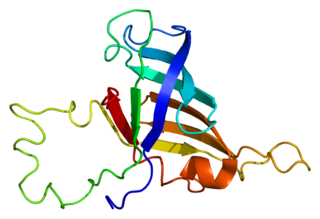
In molecular biology 7SK is an abundant small nuclear RNA found in metazoans. It plays a role in regulating transcription by controlling the positive transcription elongation factor P-TEFb. 7SK is found in a small nuclear ribonucleoprotein complex (snRNP) with a number of other proteins that regulate the stability and function of the complex.

Cyclin-dependent kinase 9 or CDK9 is a cyclin-dependent kinase associated with P-TEFb.

Cyclin-T1 is a protein that in humans is encoded by the CCNT1 gene.

DNA-directed RNA polymerase II subunit RPB2 is an enzyme that in humans is encoded by the POLR2B gene.

DNA-directed RNA polymerase II subunit RPB7 is an enzyme that in humans is encoded by the POLR2G gene.

DNA-directed RNA polymerases I, II, and III subunit RPABC3 is a protein that in humans is encoded by the POLR2H gene.

Cyclin-dependent kinase 7, or cell division protein kinase 7, is an enzyme that in humans is encoded by the CDK7 gene.

DNA-directed RNA polymerases I, II, and III subunit RPABC2 is a protein that in humans is encoded by the POLR2F gene.

DNA-directed RNA polymerase II subunit RPB9 is an enzyme that in humans is encoded by the POLR2I gene.

CDK-activating kinase assembly factor MAT1 is an enzyme that in humans is encoded by the MNAT1 gene.

Transcription elongation factor SPT5 is a protein that in humans is encoded by the SUPT5H gene.

Cyclin-H is a protein that in humans is encoded by the CCNH gene.

General transcription factor IIH subunit 4 is a protein that in humans is encoded by the GTF2H4 gene.

Protein HEXIM1 is a protein that in humans is encoded by the HEXIM1 gene.

Cyclin-T2 is a protein that in humans is encoded by the CCNT2 gene.

General transcription factor IIH subunit 1 is a protein that in humans is encoded by the GTF2H1 gene.

CTD small phosphatase-like protein is an enzyme that in humans is encoded by the CTDSPL gene.

Cyclin-K is a protein that in humans is encoded by the CCNK gene.

Protein HEXIM2 is a protein that in humans is encoded by the HEXIM2 gene.

In molecular biology, Tat is a protein that is encoded for by the tat gene in HIV-1. Tat is a regulatory protein that drastically enhances the efficiency of viral transcription. Tat stands for "Trans-Activator of Transcription". The protein consists of between 86 and 101 amino acids depending on the subtype. Tat vastly increases the level of transcription of the HIV dsDNA. Before Tat is present, a small number of RNA transcripts will be made, which allow the Tat protein to be produced. Tat then binds to cellular factors and mediates their phosphorylation, resulting in increased transcription of all HIV genes, providing a positive feedback cycle. This in turn allows HIV to have an explosive response once a threshold amount of Tat is produced, a useful tool for defeating the body's response.





















